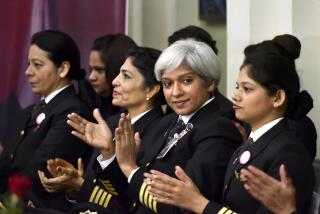Flight Attendant Turns In Her Trays, Now Wears Pilot Wings
- Share via
SAN DIEGO — After years of walking airplane aisles, Aleta Pharris finally reached the cockpit.
Once a Pacific Southwest Airlines flight attendant, Pharris’ career in the sky came full circle four months ago when she began flying PSA’s new four-engine British Aerospace 146s as a first officer.
“I wanted to work with the airline industry and I knew being a flight attendant would be a good job and a way to get involved,” Pharris said. “But it wasn’t my intention (to become a pilot) when I started that job. . . . “
Rather Be in Charge
But sometime in her 3 1/2 years as a flight attendant, she decided she would rather be at the controls than in the cabin serving passengers.
“The more I got involved with it, the more I wanted to learn and the more I wanted to fly,” said Pharris, who left PSA in 1979 to pursue a career as a pilot.
Pharris, 31, had earned her private pilot’s license shortly after she started as a flight attendant in 1976. It took three years to earn her commercial and multi-engine licenses.
Pharris, now one of 16 women among PSA’s 600 pilots, said she got a lot of encouragement as she strove to make the transition from flight attendant to pilot.
“The pilots were very supportive,” she said. “They’d let me watch and answer my questions. Then I’d take my books to work with me and when I had breaks or layovers I’d sit and read. When I’d get off work I’d go take a flying lesson. That went on for a long time.”
She now is one of about 200 pilots eligible for membership in the International Society of Women Airline Pilots. About 40,000 commercial jet pilots now fly in the United States.
“I knew there weren’t that many (female pilots), but it didn’t deter me,” she said. “There were some obstacles out there, but it certainly didn’t stop me or anyone else who wanted to do it. We simply went out and did it.”
While working for her multi-engine license, Pharris worked as a jump pilot for sky divers between stints as a pilot of twin-engine commuter planes.
After earning her multi-engine license, Pharris got a job flying for Wings West commuter airline in December, 1984. The week she spent in ground school preparing for that job was the toughest part of her career, she said.
Transition ‘A Piece of Cake’
“After working for a commuter (airline) where I had days when I had 11 flights, coming to a major carrier where . . . I might have only six flights a day, well, that’s a piece of cake,” she said.
While flying for Wings West, Pharris got her airline transport pilot rating, which is required to fly planes that weigh more than 12,500 pounds.
After 14 months at Wings West, during which she also passed her captain’s test, Pharris was at the front of the line when PSA expanded and began hiring new pilots.
Amused by Reactions
But even after a year of hauling passengers from city to city, it never fails to amuse Pharris when they do double takes as they walk by the open cockpit door as they get off the plane.
“It’s like they know I’m a pilot, but they wonder, ‘Did she really fly it? There’s got to be someone else up there,’ ” she said.
Another pilot is up there, of course, but the only difference is that the captain has seniority, which is Pharris’ next goal. The FAA estimates that about half the commercial airline pilots now flying will retire in the next 15 years, and Pharris plans to be ready to move into the No. 1 seat.
More to Read
Inside the business of entertainment
The Wide Shot brings you news, analysis and insights on everything from streaming wars to production — and what it all means for the future.
You may occasionally receive promotional content from the Los Angeles Times.










